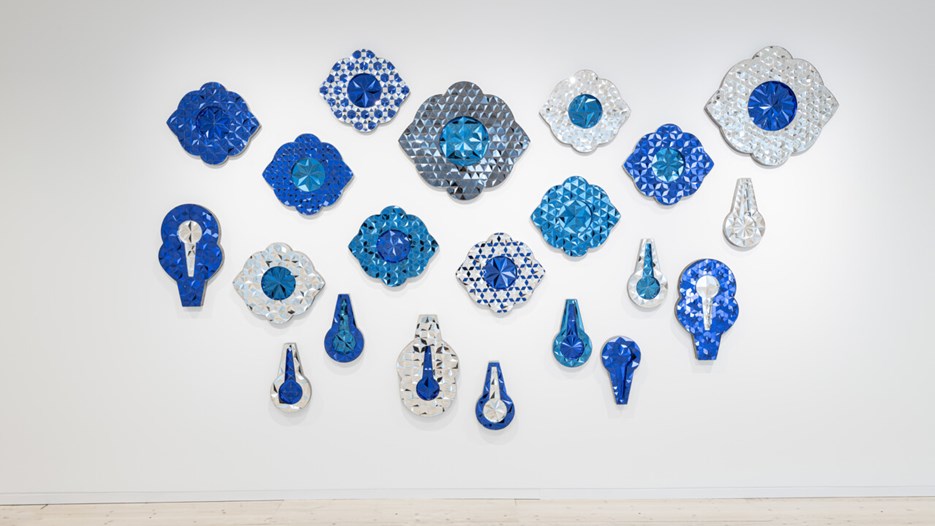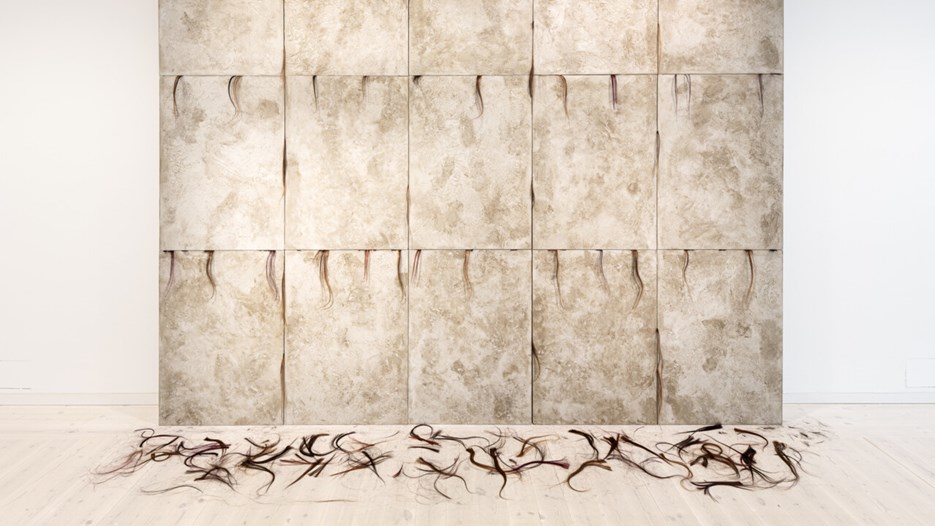Mandana Moghaddam (born 1962 in Tehran) lives in Stockholm. She has exhibited in several countries and among other participated in the Venice Biennale and the Incheon Women Artists’ Biennale in South Korea.

Mandana Moghaddam, Verk ur serien Underlandet, 2013– © Mandana Moghaddam / Bildupphovsrätt 2023

Mandana Moghaddam, What they gonna do with the inevitable growth of sprouts?, Chelgis VI, 2023 © Mandana Moghaddam / Bildupphovsrätt 2023.

Mandana Moghaddam, Kvinna Liv Frihet © Mandana Moghaddam / Bildupphovsrätt 2023.

Mandana Moghaddam, What they gonna do with the inevitable growth of sprouts?, Chelgis VI (detalj), 2023 © Mandana Moghaddam / Bildupphovsrätt 2023.
Art’s ability to bridge cultural boundaries is a central theme in Mandana Moghaddam’s work. Encompassing human communication, migration, and feminism, her art draws inspiration from Iranian cultural history and pressing topical events. Her primary media are video, sculpture, and installation with hair, mirror mosaic, and concrete as recurring materials. The exhibition shows mirror mosaic works from the series
Underlandet [The Wonderland] and Chelgis I, a human-scale sculpture covered in hair and enclosed in a glass case. The title refers to a girl in a Persian tale whose name means ‘forty braids’. Moghaddam has created the new sculpture What they gonna do with the inevitable growth of sprouts? Chelgis VI, as well as a new work in the Underlandet series, especially for Bildmuseet.
The exhibition is produced by Bildmuseet.
Artworks in the exhibition
Chelgis I, 2002
Synthetic hair, wood, acrylic glass
This work is part of a series of sculpture and video installations that Mandana Moghaddam began in 2002. The series is named after the Persian fairy tale Chelgis [Forty Braids], which is well known in Iran. Chelgis, a girl with forty braids, is captured by a demon in a beautiful garden. It imprisons her, and manipulates both the girl and the outside world. The only way that she can be freed is if someone finds and destroys the bottle which holds the demon’s power and spirit. A prince breaks the bottle, thereby freeing Chelgis.
Moghaddam reinterprets the fairy tale, depicting Chelgis as a human-like figure who is completely covered by long hair, in the form of both braids and loose strands, enclosed in a glass cage. The sculpture creates the illusion of the figure being seen from behind, but as you walk around it in search of a face, it constantly appears to be turning away. She stands there, seemingly calm and still in her glass prison, while her hair grows and emerges from under the glass down at floor level. There is an ambiguity in the way the figure is fully enclosed by hair. It both covers her like a veil – as a form of enforced or self-chosen protection – and exposes her, as in an act of resistance against the Iranian regime’s demands that women should cover their hair.
The sculpture was created to be exhibited in Iran in 2002, but was censored despite art experts insisting that it depicted the theme of the ancient fairy tale, rather than contemporary women. The oppression of women, combined with defiance and resistance, is a unifying theme in Moghaddam’s interpretations of the Chelgis tale. Female hair appears as a symbolic material throughout the works in the series. Three versions of the sculpture Chelgis I have been produced.
Moghaddam often draws on her own memories and experiences in her artistic work. Taking personal experiences as a starting point, her art addresses issues of cultural and gender-based violations of human rights; issues of exile, exclusion and isolation. As a woman and a refugee herself, and having experienced a regime that oppresses women, she depicts and criticizes the things she has been subjected to. At the same time, there is an ambiguity in her work that allows for multi-layered readings of universal human issues that we can all recognise, regardless of who or where we are.
Underlandet, 2013–ongoing
[The Wonderland],
Mirror glass, plywood, plaster, glue, metal
Underlandet is an ongoing series of sculptural objects made using the centuries-old Iranian mirror mosaic technique of aina-kari, in which finely cut pieces of different coloured mirror glass are arranged in geometric, leaf-like or calligraphic shapes. The technique emerged in the 17th century, when costly glass was imported from Venice for the ornamentation of palaces and mosques. Some of the glass broke during the long journey, and the shards were used as a material for light-reflecting wall mosaics in complex, abstract patterns. In particularly lavish buildings, entire walls could be covered with mirror mosaics in intricate patterns.
Mandana Moghaddam first used aina-kari in 2013 when she created works for a stairwell at Stockholm’s Söder Hospital and for an exhibition in Teheran. It was the tower-like architecture, the light and the open view from the building’s seven storeys that gave her the idea of working with mirror mosaic. The thousands of mirror pieces reinforce the experience of space, giving the impression that our gaze can wander infinitely.
The Underlandet series is named after Lewis Carroll’s Alice’s Adventures in Wonderland. In each of the small mirrors that make up the works, viewers can discover themselves or the world in new ways. The mirrors reflect light from the world and fragments of reality as we recognise it, but perhaps from a new angle or a completely different perspective. In the mirror glass we can catch a glimpse of a different, unknown world – a mirror world in which to lose ourselves.
The works in the exhibition have been sketched out by hand by the artist. The mirror pieces are placed in a mass of plaster and glue, and the works are surrounded by thin strips of metal. The shapes are reminiscent of plant parts, eyes, drops of water, keyholes and tears. The viewer is playfully invited to look into the works, encountering infinite facets of themselves or the surrounding world. Works from the Underlandet series are displayed on floor 4 of Bildmuseet and in the reception area.
What they gonna do with the inevitable growth of sprouts? Chelgis VI, 2023
Cellular plastic, plaster, fibre mesh, pigmented soap, human hair
In her new work What they gonna do with the inevitable growth of sprouts?, Mandana Moghaddam has again used hair as a symbolically charged material. Something resembling a solid wall of grey concrete has been erected in the exhibition space. In the joints between the blocks, we see thin strands of dark hair. Have they been embedded into the compact wall, or are they emerging through the joints?
Since the early 2000s, human hair has been an important element in Moghaddam’s work. Cut-off hair, suspended braids of hair, or – as is the case here – strands of hair breaking out like stubborn vegetation pushing its way through asphalt. Like many of her works, this sculpture conveys a duality, an oscillation between hopelessness and resistance; between despair and glimmers of hope.
Artwork outside the exhibition
Vinden bär oss med sig, 2015
[The Wind Carries Us Along]
Cast concrete, iron, lamp, sound
Commissioned by the Swedish Public Art Agency, Mandana Moghaddam has created the outdoor work Vinden bär oss med sig (2015) for Vindarnas torg between the University Library and the Humanities Building on Umeå University’s main campus, less than two kilometres from Bildmuseet on Umeå Arts Campus. This is a room without walls, featuring a bed with bedclothes, a desk, a chair, two stools, a desk lamp and a rug, all in cast concrete. The pattern of the rug is reminiscent of a Persian rug. The room is open for anyone to enter. Those who approach the sculpture see the light from the desk lamp and hear voices: sounds of telephone conversations between people from different parts of the world. The artist invited students and the public to become part of the artwork by calling anyone, anywhere in the world, while recording the conversations that we can now hear in the open room.
When Moghaddam created the sculpture, she wanted to reconnect with her memories of the refugee facility in Kristineberg, Västerbotten, where she lived when she first arrived in Sweden in the 1980s. The simple furniture harks back to her room in Kristineberg, but is also reminiscent of a student room. The pattern on the rug may be a reference to a room she left behind in Iran, and which has now been turned into stone in her memory.
The sculpture transforms Moghaddam’s own experiences as a refugee into a space that is open to everyone. It addresses one of her recurring themes: the vulnerability of human communication. Today, thanks to the internet and social media, we can hold conversations and exchange information across geographical distances and national borders. However, when the artist had just arrived in Sweden in 1987, her only contact with her mother and her home country was via a telephone outside in the harsh cold of a Swedish winter. There was a war going on in Iran, and her calls sometimes went unanswered.